6. Spartacus (1960)
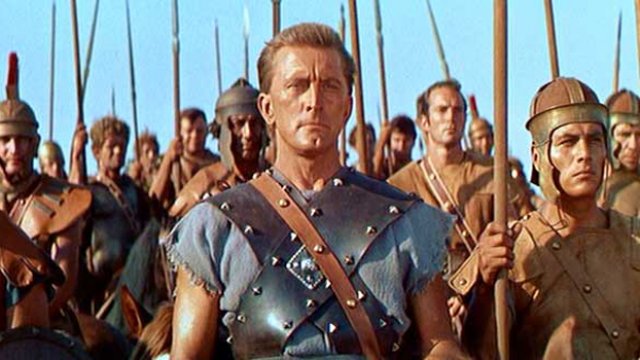
Kirk Douglas made Spartacus after William Wyler chose Charlton Heston (this guy again) to star in Ben-Hur instead of him. He wanted to prove to the director that he too, can make an epic movie. Based on a Howard Fast novel and written for the screen by then blacklisted Dalton Trumbo, Stanley Kubrick (only 32 at the time) was chosen to direct.
The director proved to be very difficult to work with and clashed with everyone from writer to actors to the crew. But, who could blame him? Not when Laurence Olivier, Charles Laughton and Peter Ustinov consistently acting as backseat drivers. Kubrick didn’t have the control he wanted and would later disown the movie.
On the side, Charles Laughton was threatening to sue Douglas while Tony Curtis and Jean Simmons wanted a way out. There apparently, a gladiatorial battle arena happening off camera. Spartacus was a very difficult movie to make.
With a then unheard of budget of $22 million, the movie was shot in a span of 167 days. 10,500 comprised the cast and crew, 100 major sets were made and 5,000 uniforms, 7 tons of armor and 27 tons of statues were borrowed from Italian museums.
In a battle scene shot in Spain, Kubrick made use of 8,800 Spanish army troops as Roman legion. Production notes that around 50,000 (maybe more) extras took part in battle scenes. Phew! According to experts, if you make Spartacus today would cost in the vicinity of $110 million.
The story of Spartacus is indeed, born out of numbers. Born in Greece, Spartacus led 78 gladiators in a revolt against their masters which ballooned to 90,000 as he roamed, freed slaves and recruited his army to fight the might of Rome. In 71 BC, they met defeat in the hands of Marcus Licinius Crassus (Olivier). Captured, Spartacus and what remained of his army, awaited their fate.
Which leads us to one of the most memorable scenes in the movie. Asked to identify Spartacus so that they will be spared the painful death of crucifixion, the slaves made a startling gesture. When Spartacus (Kirk Douglas) stood up, Antoninus (Tony Curtis) beat him to it and shouted, “I am Spartacus!” Almost immediately, everyone followed one after the other, proclaiming the same, “I am Spartacus!” and eventually sealing their fate. That scene, along with the famous line, rank among Hollywood’s most memorable.
7. Waterloo (1970)
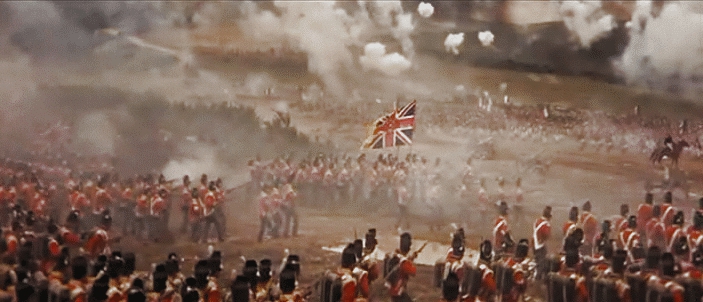
The Dino De Laurentiis brand of movies is often synonymous with the word spectacular. Movies like War and Peace (1956), The Bible (1966), King Kong (1976), Flash Gordon (1980), Conan the Barbarian (1982), and Dune (1984). In some instances, his name appeared above the title. In 1970, DeLaurentiis produced a movie about Napoleon Bonaparte portrayed by Rod Steiger and directed by Sergei Bondarchuk. The movie is Waterloo—an epic war movie with huge battle scenes that would awe soldiers and generals alike.
In 1815, facing defeat from France’s enemies (the Sixth Coalition that included Great Britain, Austria, Prussia and Russia), Napoleon was forced to abdicate and was sent in exile to the island of Elba only to escape and return to France en route to one of the most famous battles in history—a showdown against the Duke of Wellington (Christopher Plummer). It’s the kind of war won by tactics more than the skill of every soldier. They march to battle in squares, never breaking ranks unless killed—the kind of battle you wish you had a machine gun.
Before the battle broke out, Wellington surveyed the battlefield and said of the French army, “Dramatic fellows these French. Music and banners. Quite beautiful.” Indeed, the battle formations are a sight to behold.
And to make the battle of Waterloo a reality, 15,000 soldiers of the Soviet Army, including 2,000 cavalrymen were employed. Before shooting began, the extras were trained for weeks in 1815 drill and battle formations and also in the use of sabres, rifles and cannons. Like a general, Bondarchuk controlled the multi-national battalions of extras using a walkie-talkie, relaying commands through officers, with four interpreters (English, French, Italian and Serbo-Croatian) by his side.
Without the help of special effects, it was a full scale re-enactment of the battle of Waterloo, infantry and cavalry and all, featuring cannon fire, rifles, swords, and lances. It was like watching a war movie with that much soldiers you’d witness in an actual war. No camera tricks there. A full cavalry charge by the French Marshal Michel Ney (Dan O’Herlihy) spanned acres of land and dwarfed every other movie cavalry charge that came before it. In the aerial shots, one would wonder how the camera was able to capture its vast scope.
The movie was filmed in the Ukraine and completed in 28 weeks. Unfortunately, it didn’t do well in the box office and some critics pointed out some historical inaccuracies. Still, Bondarchuk’s movie is the definitive Napoleonic war movie. An eye candy as far as battle scenes go, it was, and still is, every war nut’s wet dream. C’est magnifique!
8. Gandhi (1982)
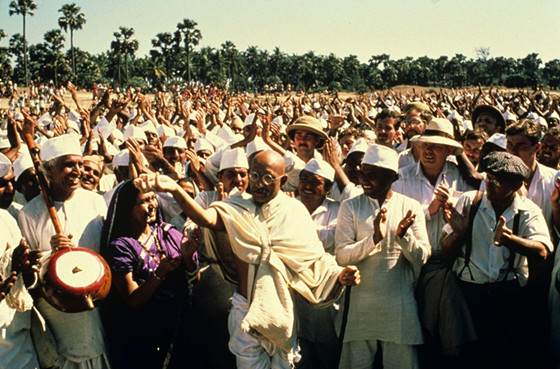
It took 18 years before Sir Richard Attenborough was able to start filming his “dream” project. In 1962, he received a call from the Indian High Commission in London and met with Prime Minister Pandit Jawalharlal Nehru and came to terms. But, several setbacks including Nehru’s death impeded the making of the film until finally in 1980, it was Nehru’s daughter and then PM Indira Gandhi who committed $10 million and shooting began on November, 1980.
Naturally, casting the lead role was of serious concern. The Indian film industry’s intellectual filmmakers not only objected to the $10 million given to a foreign film production which they argued would have financed 30 Indian art films, they demanded that an Indian should play Gandhi. Nasseruddin Shah, a famous Indian actor and director nearly got the part but felt that he didn’t stand a chance when Richard Attenborough saw Ben Kingsley’s screen test.
Gandhi was such a fit for Kingsley who is part-Indian (his father was Gujarati, the ethnic group from which Gandhi also belonged), that many Indians who saw him garbed in the role thought that Bapu Ganhiji had resurrected.
Almost all of India wanted to be part of the movie (save for the Sikh). Guinness Book of World Records lists the movie as having the most extras in a scene. The scene was Gandhi’s funeral with around 300,000 extras were present. 200,000 of which were volunteers and the rest were paid a fee (the going rate was from 15 to a 100 rupees, depending on the role).
It was shot on January 31, 1981, the 33rd anniversary of Gandhi’s death, which explains the deluge of volunteers. Also, prior to the scene, Attenborough had placed ads on newspapers informing people who wanted to watch the shoot to come in simple clothing. It was said to have been a most emotional day. People thought it was the real thing and some were actually weeping.
SIDE NOTE: There were instances of racism during filming. According to John Mathew Matthan, a 1st assistant director: “Some Brits would act as though they were still ruling India.” This was best exemplified when a British assistant director told a fellow Indian AD, “Get me a cup of tea.” To which the Indian replied, “The Raj left many years ago.” When the news reached the benevolent Attenborough, he was said to have shouted, “If they’re rude to you, you give them back. If somebody abuses you, you abuse him back!” And Gandhi would have told them to keep their cool.
9. The Last Emperor (1987)
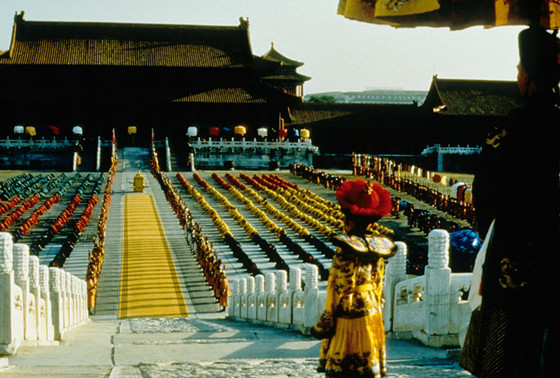
So the story goes that when Queen Elizabeth II of England made a state visit to China in 1986 and was to go to the Forbidden City, she was unable to because there was a movie being made inside the walls. The movie, of course, was Bernardo Bertolucci’s Academy Award winning The Last Emperor about the life of Pu Yi, who was only 3 years old when he was made emperor of the Qing dynasty. The scene was an important one, his coronation, which obviously, was favored over the Queen.
Whether the story is true or not, still implies how the Chinese government was 100% behind the movie. And were talking about the People’s Republic of China, which allowed for the first time to open the city to a Western film production. Bertolucci was given absolute freedom to make use of the visual magnificence of the historic place.
The Chinese government even ordered 2,000 of their soldiers to have the front of their heads shaved in order to play Qing banner men. Persuaded by their supervisors to do so as a sign of friendship to the Italians and British, they also got a $3.50 tip. It’s a good thing those soldiers weren’t vain.
And the 2,000 were only part of the 19,000 extras used in the movie. The pre-production of the Last Emperor attracted double that figure of extras wanting to be in it. Like Gandhi, It was a big event in its country at the time.
Giancarlo De Leonardis, the chief hairdresser imported 2,200 pounds of real human hair to design the wigs that were worn. Some 9,000 different costumes were sewn which came from a budget of $25 million. The movie which took 16 weeks to film, was characterized as being a well-made, very cooperative international production which in the end prevailed by winning the 9 awards it was nominated in.
10. The Lord of The Rings Trilogy (2001, 2002 & 2003)
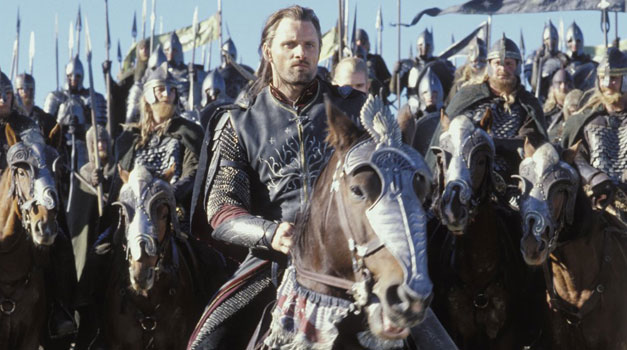
Even with the revolutionary special effects made by Weta Workshop using the MASSIVE computer program that could whip up tens of thousands of orcs, elves and men in the comfort of their studio, Peter Jackson’s Lord of the Rings Trilogy still gave jobs to 20,602 extras.
While MASSIVE created armies as far as the eye could see, those high-angled shots that left Grima teary-eyed, on ground fighting like in the Battle of Helm’s Deep, the siege of Minas Tirith, Pellenor Fields and the Black Gate, required real actors, extras by the thousands.
To outfit the extras and make sure they look Middle-Earth, a production team of over 2,400 toiled to produce 48,000 pieces of swords, scabbards, shields and axes, 900 suits of armor, 300 hand-made wigs, 500 bows, 10,000 arrows, 200 orc masks, 15,000 various costumes and 1,800 pairs of Hobbit feet. And these are no ordinary props. Attention to detail is the operative word.
In the Two Towers, Elven suits of armor were themed to Elves leaving Middle-Earth and thus carried Autumnal colors, while the Rohirrim costumes were based on Germanic and Anglo-Saxon patterns. To give an idea on the depth of work they have put into the movie, one sword took 3-6 days to make and 12,500,000 metal rings were hand-linked to create the chain mails.
Some of the extras, like the New Zealand Defense Forces doubled as manual laborers by ploughing fields, tending gardens and building sets which made up Hobbiton. This created a bit of a controversy on how workers and extras were treated. Not only were they paid too little, they were said to have been treated like slave labor and weren’t provided with proper sleeping arrangements.
Nonetheless, the long-time effect the trilogy has on New Zealand is evident. Since it is relatively cheaper to film a movie in New Zealand, the aftermath of LOTR created more jobs, specifically with studios that Jackson co-owned like Weta. Not only that, New Zealand has increased tourism by 50% since then.
Peter Jackson actually had a hand in increasing the GDP of a country. That New Zealand has so embraced LOTR that customs service stamps “Welcome to Middle-Earth” on visitor’s passports. No, that’s an extra charm.
Author Bio: Geonard Yleana is a writer, illustrator and publishes independent comic books. His taste in cinema expands worldwide and across all genres and timelines.